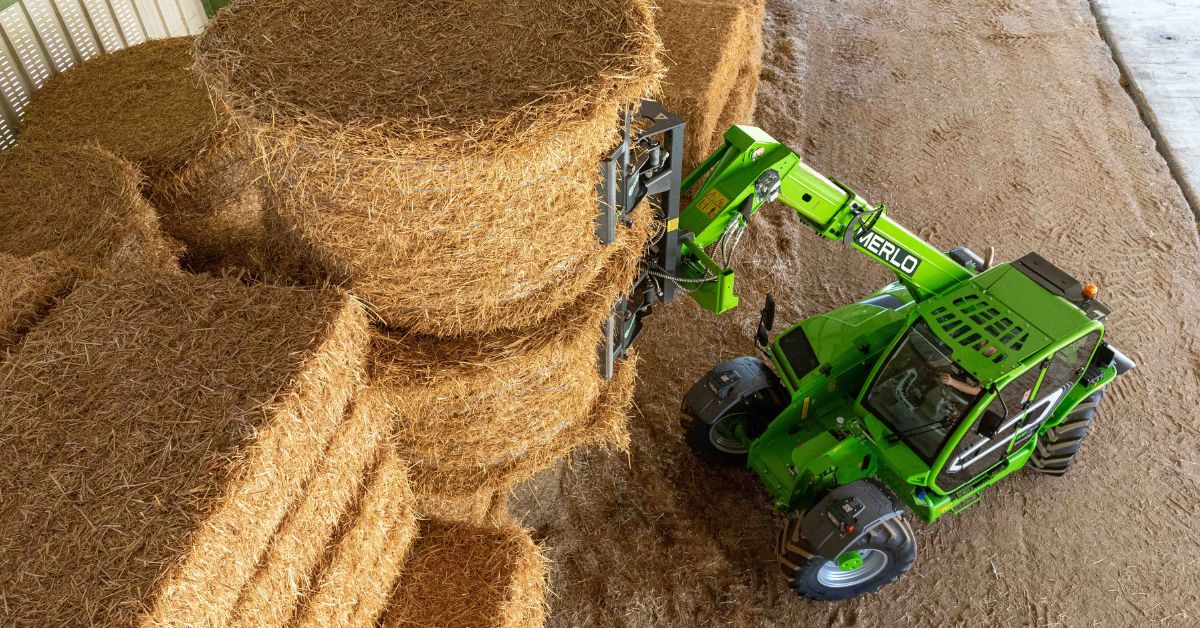
What are telehandlers?
Definition, functions and features
What is a telehandler: technical definition
A telehandler is a multifunctional operating machine equipped with an extendible telescopic boom, designed to lift, transport and position materials at different heights and distances. It is used in a wide variety of sectors, from agriculture to construction, from logistics to the forestry industry.
Compared to other lifting means, it stands out for its wide operational versatility, its ability to adapt to tight spaces, and the possibility of mounting various attachments by means of quick couplings. Merlo models, in particular, combine technology, safety and innovation to offer high performance in any working context.
The structure of a telehandler
A telehandler is a multifunctional operating machine equipped with an extendible boom capable of lifting, transporting and positioning loads at different heights and distances. The structure consists of a chassis with four-wheel drive, an operator cab and a hydraulic system.
Differences between fixed and rotating handlers
Fixed handlers, such as Merlo’s stabilised telehandlers, feature a telescopic boom that extends to the front and are ideal for applications where turret rotation is not required. Rotating models, such as the Roto range, allow 360° rotation of the turret, offering greater versatility in confined spaces or for working at height.
How a telehandler works
Born from the need to combine the functions of a crane, a forklift and an aerial work platform, the telescopic machine has evolved over the years thanks to continuous technological innovation. Merlo has played a leading role in the development of increasingly advanced and safe solutions, helping to set new industry standards.
The principle of telescopic boom extension, handling and control systems
t the heart of how it works is the telescopic boom, made up of tubular elements that slide one inside the other, driven by hydraulic cylinders and mechanical transmissions. This mechanism allows reaching high heights and significant outreach while maintaining the compactness of the machine at rest.
The telehandler is manoeuvred using a multifunction joystick and digital displays, which allow simultaneous control of steering, speed, boom extension and attachments. Merlo models incorporate proprietary technologies such as the Adaptive Stability Control System (ASCS), which monitors the load in real time and ensures maximum operating safety.
Thanks to the quick coupling and auxiliary hydraulic system, the telehandlers can be equipped with a wide range of attachments: skips, forks, winches, man baskets, clamps and many more. This versatility allows the machine to be adapted to many different operating contexts.
Technical features of telehandlers
Merlo models cover a wide range of needs, with lifting capacities ranging from 2.5 to over 12 tonnes, and operating heights reaching 35 metres in Roto models. This performance makes them suitable for both agricultural and industrial applications.
Engines, stability and safety during use
Stage V engines ensure power and compliance with environmental regulations. Four-wheel drive, four-wheel steering and tilt correctors allow safe operation on any type of terrain, even on slopes or in poor grip conditions.
Stability is ensured by features such as the compact chassis, low centre of gravity, central boom and electronic control systems. The rotating models have automatic stabilisers for maximum safe operation even when rotating and lifting at extreme heights.
Merlo cabs offer a high ergonomic standard, panoramic visibility, active suspension and intuitive digital interfaces. The control management is smooth and precise, reducing operator fatigue and increasing efficiency in prolonged operations.
Where and why to use a telehandler
In modern agriculture, Merlo telehandlers play a central role: loading feed, handling bales, cleaning barns, lifting equipment. Their versatility allows them to replace several machines with a single multi-purpose vehicle.
On construction sites and in production areas, telehandlers facilitate the transport of heavy materials at height, the positioning of prefabricated elements and the support of internal logistics.
The compactness of some Merlo models makes it possible to work in difficult environments, such as rows, nurseries, city centres or industrial areas with limited passageways. The reduced dimensions and high manoeuvrability also make these machines ideal for use in tunnels or greenhouses.
The advantages of Merlo telehandlers
With a wide range of models and attachments, Merlo offers tailor-made solutions for every sector, guaranteeing quality and reliability in every operating context thanks to the modularity of its telehandlers.
Constant research on materials, engines and digital technologies allows the development of more efficient machines, reducing consumption and environmental impact, in line with the latest European standards.
Maximum visibility and safety for the operator
The position of the cab, the wide glass surface and the ergonomics of the interior give the operator total control of the working environment, increasing the level of active and passive safety.
Merlo telehandlers are designed to last. Every component is selected to ensure robustness, low maintenance and consistent performance even in the most demanding conditions.
Why choose a Merlo telehandler for your job
Choosing a Merlo telehandler means investing in a machine designed to meet every operating challenge with safety, efficiency and innovation. Thanks to a complete range, patented technologies and a widespread service network, Merlo is the ideal solution for those looking for high performance and reliability over time in every professional sector.